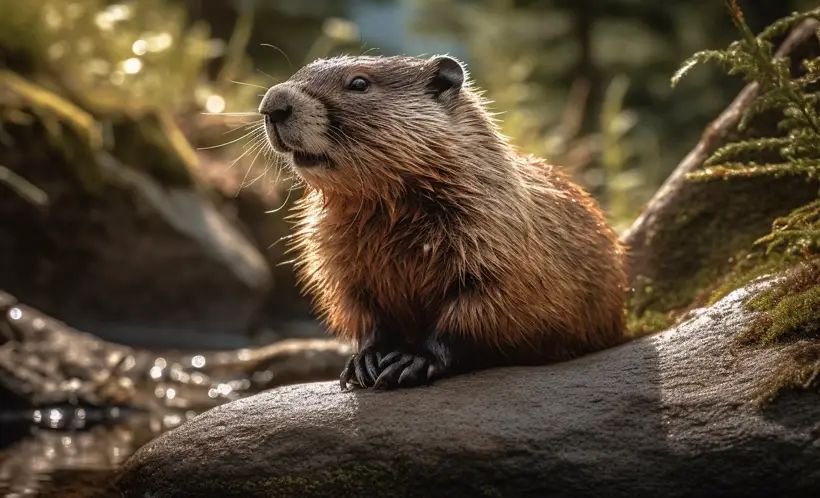Do Marmots Hibernate? Understanding Marmot Behavior and Adaptations
Marmots are fascinating creatures as of their unique behavior and adaptation nature. These oversize ground squirrels fit in the medium-sized rodents category and mostly dwell in mountainous regions of North America and Eurasia.
Since the weather of the Marmots’ habitat is not favorable because of food scarcity and extreme temperatures, many ask, do marmots hibernate? Yes. They are among a few rodents that hibernate during winter to survive.
By understanding the marmot habitat preferences, hibernation and adaptations, you can better learn to conserve their habitats. And for that purpose, in this article, we will shed light on marmot behavior and adaptations during hibernation. Let’s get to it!
Marmot Hibernation
Marmots are among a handful of rodents or mammals that hibernate in chilly months. Since during hibernation, Marmots are not active; they leverage their body reserves to keep them alive.

Below we are discussing some important points of marmot hibernation:
The Physiology of Marmot Hibernation
During hibernation, the rodent enters into a torpor (inactive state). Simply put, it is a deep sleep-like state where marmots drop their body temperature, heart rate, and breathing to shallow levels.
But what good does that do to them? Hibernation is an important aspect of Marmot winter survival strategy. Marmots can save energy and better survive the harsh winter months of Alpine woods when there is no food and temperatures are in minus degrees.
Since marmots are inert during this time, they do not eat or drink anything. They depend totally on their body fat reserves to survive. However, marmots do wake up momentarily after a few weeks.

During this brief awakening, they drink water to hydrate and excrete waste. But remember that they do not come to the senses as they remain in a deep sleep-like state during awakening. Without hibernation, the Marmots can’t survive the Harsh Alpine winters when food and water are scarce.
Patterns and Duration of Marmot Hibernation
Typically, the marmot hibernates for 5-9 months, starting from late fall to early spring. The hibernation period of the marmots depends on a few factors, such as:
- Marmot specie
- Geographic location
- Weather and environmental conditions
For instance, the Olympic marmot primarily found in the USA sleeps for nine months. On the other hand, the British Columbian hoary marmot will hibernate for around six months.
Besides, the hibernation period also hinges on environmental factors like temperature, snow, and food accessibility. For instance, in warmer regions of America, the marmot will hibernate later in the fall month, while in colder parts like Eurasia, they will hibernate earlier.
Moreover, the marmots start accumulating food and building fat in the summer months to prepare for the long haul. Furthermore, they also make comfortable nesting spots and elaborate burrows in wildlife habitat with multiple chambers where they will hibernate for a long time.
Goods and Bad of Marmot Hibernation

When the Marmot enters into a hibernation state, two things happen to them.
- First, their body temperature decreases significantly to as low as 5-7 degrees Celsius. Second, their heart rate and breathing can become shallow too, which can get to as low as one breath per minute.
- Marmots can stay hibernated for up to 8 months out of the year, starting from the end of fall to the start of spring or when food gets scarce until food becomes available.
- One of the major advantages of Marmot hibernation adaptations is their ability to fight mountain habitats. They can fight through the winter ecology for months without food.
But this mammal behavior is not without the downfalls, such as :
Poor Immune System
During hibernation, when the metabolism and pulse of marmots are down, their guard against viruses and bacteria is also down. Result? They are more susceptible to disease and infection.
Weight Loss
Since marmots will use their fat reserves to survive the winters, it will make them weak and lean. In fact, it will take a lot of work for marmots to thrive and breed successfully.
Conservation and Management of Marmots and Their Habitats
Marmots are enticing creatures, but some species are endangered and need conservation efforts. For example, the Vancouver Island marmot is critically endangered as per Canadian Species at Risk Act.
Moreover, the Olympic marmot is also endangered (second rarest) according to the U.S. Endangered Species Act. In contrast, the Himalayan marmot is the least vulnerable on the IUCN Red List of Threatened Species.

But what is the contributing factor for such species endangerment? Some of the significant factors are:
- Habitat loss
- Climate change
- Human disturbance
If a marmot encounters habitat loss and fragmentation, it might not have access to food and water. Moreover, any environmental change will disturb their hibernation cycles leading to a reduced survival rate.
And lastly, human interventions will make them vulnerable to predators leading to species endangerment.
So for marmots to survive for long, it is essential they hibernate enough. By maintaining their wildlife behavior of hibernation and public education, we can ensure these members of alpine ecosystems survive for long.
In addition, many researchers and scientists also study marmot hibernation behavior and physiology. With these studies, we can unveil how these marmots adapt to changing environmental conditions.
Frequently Asked Questions
Below we are mentioning some of the most important questions that you might ask regarding marmots hibernation.
Do all marmot species hibernate?
Almost all marmot species hibernate to survive the weather with some duration difference. Here is the hibernation duration for different marmots:
- The Olympic marmot (Marmota olympus) hibernates for as low as five months.
- Hoary marmot (Marmota caligata) hibernates for shorter periods, from October to February.
- The yellow-bellied marmot (Marmota flaviventris) may hibernate for up to 8 months.
Note that some marmots refrain from hibernating as well.

The Alaska marmot (Marmota broweri) and the Vancouver Island marmot (Marmota vancouverensis) don’t hibernate at all. But how do they survive, then?
They leverage other adaptation techniques to survive mountain ecology. For instance, they might burrow underground and escape extreme weather. Moreover, they also devour a special plant diet and insects that they can eat year-round.
So, most marmots do hibernate but with some difference in their duration.
How do marmots prepare for hibernation?
The marmots start to prepare for the hibernation period before the time comes. For that, they will do the following:
Building up fat stores
Since they have to use all fats stored in the body during winter, they will devour food in summer to accumulate enough fat in the body. During summer, they will eat a lot to have a fat stock full.
Finding or creating a burrow
They will make a safe spot for them to hibernate. Since they will reside in their burrow for months, they will make for a good one. Moreover, they will also polish the existing burrow. In addition, they also make sure that their dwelling has different chambers so they have good shelter and protection.
Reducing activity
As the summer ends and winter approaches, the marmots gradually decrease their activities. They reduce their foraging endeavors and interact with other mates to warm up themselves for the resting time ahead.
Lowering body temperature
Since the marmot’s body temperature will drop significantly during hibernation, it cannot happen overnight. For that, marmots have to practice lowering their body temperature.
In fact, there is a term for this practice “pre-hibernation hypothermia.” This will help them preserve body temperature for a long time.
With these Marmot hibernation adaptation practices, they can successfully survive through the harsh winter months.
What happens to marmots if they are disturbed during hibernation?
Since marmots are in deep sleep during winter, waking them up from this state is not a good idea. Why? Because they are conserving energy during this state and restarting their body systems will need significant energy, wasting their precious energy resources.

Below are some of the possible consequences of awakening hibernating marmot.
Reduced survival:
As we mentioned earlier, the marmots’ immune guards are down during hibernating, so waking them up will reduce their survival chances. In particular, if you wake them up every now and then, they will not be able to fight microbes and are more prone to get diseases.
Moreover, they will not have the energy to forage for food in the summers ahead.
Disturbed torpor patterns
Disturbing during hibernation means forcibly awakening the marmot from its torpor or inertia state. Result? They cannot continue with their normal hibernation patterns.
With forced awakening, they will have a higher metabolic rate to fuel the body, excessive use of energy reserves, and reduced fat supplies. All of these contribute to the marmots’ low survival rates.
Increased stress
Disturbing marmots in their hibernation not only disturbs them physically but also mentally. Thus, increased stress levels of marmots will also impose great health and well-being threats. Why? Because it can lead to immune function compromise and more vulnerability to infection.
Moreover, it makes them less capable of coping with other environmental stressors, giving them less survival success.
On the whole, disturbing the marmot during hibernation is not a good idea since it entails a great risk to their survival success. So it is important to keep yourself away from their dwellings and burrows so they can hibernate properly.
Besides, you should also make sure there are no loud noises and movements around their homes so they can restfully spend their winters. In fact, some wildlife photography experts search for them to click a shot during their hibernation period, but that will disturb them and put them at survival risk.
Conclusion
Hibernation is an important winter behavior of mammals that lets them survive harsh weather. Mammals like Groundhogs and marmots hibernate to glide through harsh alpine winters successfully.
On the other hand, some animals like squirrels don’t hibernate instead they rely on their food stash in their den. Marmots are amazing mammals with good adaptation and behaviors for the tough times of the year.
And by understanding them, we can gain better insight into marmots’ ecology and conservation. But still, there is a need for extensive research on marmots’ unique behavior. It will help in conservation endeavors to preserve these precious alpine species.




